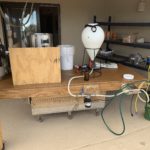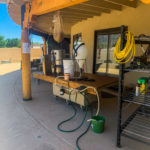On days when I home-brew beer (today is one of those days) there are 2 – 1 hour periods of time during the process where I’m having to wait on things to cook. That gives me time to think and today I thought, I like beer. That led me to Google “I Like Beer” just to see what would come up. If you are like me, you already know where that search was going. No, not Tom T. Hall.
The search led to public comments by one of our most erudite arbiters of the law in the United States. Comments he made during his confirmation hearings have inspired millions to loose the guilt about feeling love for a simple, beautiful, golden libation. Having read a lot of history about our country’s founders and prominent figures in our past, all I can do is add my own congratulations to justice Kavanaugh and acknowledge that this guy is fresh if nothing else. Let’s hope his Supreme Court opinions prove to be similar in quality to his opinions on beer.
Today, I’m using the new brew table to put a 6 gallon batch of American Pale Ale (APA) in the fermenter. Recently, I took some wooden crates my tractor dealer gave me, topped them with treated plywood and repurposed them into this brew table. It helps keep things organized, it’s on wheels and fit’s pretty well in the patio space behind our house. It includes a wind screen and places to bolt on my brew pump and counter flow chiller and even a coat hook to hang hoses during different points in the brewing process.
The APA is one of 3 “go-to” recipes that I’ve been trying to perfect over the last couple of years. Beersmith3 software helps by allowing me to tweek recipes based on prior results and also to record critical water volumes, sugar levels (gravity) and temperatures. Beersmith3 is basically a recipe developer for home brewers that provides a huge library of developed recipes and a great format for developing your own new recipes. As the recipe is developed, Beersmith3 will tell you instantly whether any change to the recipe would be congruent with the style of beer you are trying to make. It keeps you in the range of the style guidelines and “in bounds” so you don’t get an unwelcome knock on the door by the dark suited agents of the Brewers Association.
Beer is a lot like music. Musicians have made a myrid styles of music over many centuries by arranging different combinations with 12 simple notes. Brewers make a myriad styles of beer by doing the same with 4 notes (ingredients) including: Water, grain, yeast, and hops. For all intents and purposes, that’s it. The difference between one style or the other simply has to do with ratios of these common ingredients and variations in how the process unfolds – i.e. different temperatures during fermentation to make a dry or sweet beer and contact times for the aromatic hops to add bitterness and aroma. My “go-to” styles are the APA, an English Brown Ale, and a Vanilla Porter. A fifth ingredient is introduced in the latter as I drop vanilla beans we bought in Mexico City into the keg when I begin to carbonate the dark, rich brew.
It’s all a lot of fun playing around and perfecting different recipes. I don’t get too fancy and tend to stick to fine tuning my standard brews. The table has been a great help in getting my brew sessions organized and given me more time to engage in other productive activities while I brew. In the picture at right you can see the BIAB (Brew in a Bag) bag full of grain hanging and draining in to the brew pot just before boiling. Just like making a big cup of tea! Oh, it’s time to drain the brew from the pot, run it through the chiller and drop it, and the yeast, into the white, conical shaped fermenter shown in both pics. Before I do, I’ll pour a cold, home-brewed beer to enjoy during this final step because, like our newest SC Justice, I like beer.




